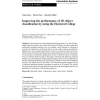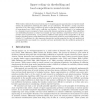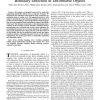1653 search results - page 293 / 331 » Adversarial Sequence Prediction |
KAIS
2006
13 years 10 months ago
2006
Abstract It has been proven that districted matching schemes (e.g., the US presidential election scheme, also called the Electoral College) are more stable than undistricted matchi...
NECO
2008
13 years 10 months ago
2008
While evidence indicates that neural systems may be employing sparse approximations to represent sensed stimuli, the mechanisms underlying this ability are not understood. We desc...
NAR
2006
13 years 10 months ago
2006
The Simple Modular Architecture Research Tool 10 (SMART) is an online resource (http://smart.embl. de/) used for protein domain identification and the analysis of protein domain a...
TIP
2008
13 years 10 months ago
2008
We propose a principled framework for recursively segmenting deformable objects across a sequence of frames. We demonstrate the usefulness of this method on left ventricular segmen...
AI
1998
Springer
13 years 9 months ago
1998
Springer
The absolute loss is the absolute difference between the desired and predicted outcome. This paper demonstrates worst-case upper bounds on the absolute loss for the Perceptron le...



